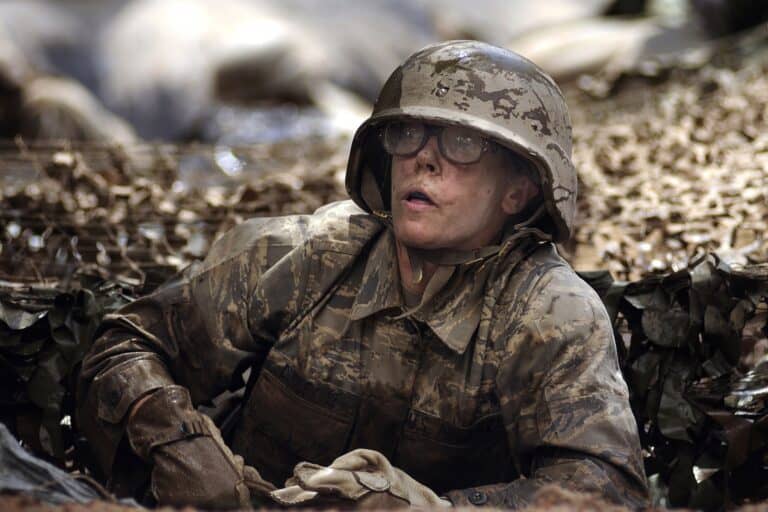You’ve probably heard of a hasty fighting position if you’ve spent any time in the military, especially combat arms, or if you’ve been deep into guns and tactics.

soldier inside foxhole
But how does a hasty fighting position differ from other traditional fortifications and cover points? What exactly is a hasty fighting position, and why does it matter?
A hasty fighting position is an improvised cover point utilizing natural terrain and materials or debris that can provide small arms protection for a single soldier or fighter. They’re easy to in place, and often improved over time as resources allow.
The hasty fighting position is the fundamental type of fortification that any shooter should be able to utilize in the field.
A mainstay of infantry operations for many decades, it is still crucially important today.
Keep reading, and I’ll tell you everything that you need to know about the hasty fighting position and how it is employed…
What are the Elements of a Hasty Fighting Position?
A hasty fighting position, according to the strictest interpretation, must provide small arms protection, that is cover, to the front for a single soldier while still allowing that soldier to return fire to the obliques and straight ahead.
In essence, the hasty fighting position might be a conveniently placed concrete barricade, a substantially thick tree, a small hill or mound of dirt, or anything else that can block gunfire while allowing the person taking cover behind it to return fire to the same direction and off to either side.
Perhaps most notably, the hasty fighting position at most will only shelter a single shooter, as compared to the more substantial and protective two-man fighting position.
[TAG1]
A Hasty Fighting Position Might Not Provide Cover to the Obliques
Ideally, a properly chosen or improved hasty fighting position will provide a certain amount of cover to the obliques, that is either side, of the trooper using it but this is not strictly required.
Obviously, it is very nice to have such protection, but not strictly required!
So long as the fighting position is oriented to provide frontal cover in the direction that the threat is present in or suspected, it is considered adequate as long as the trooper can return fire in the same direction.
Do You Need to Dig a Hasty Fighting Position?
Ideally, a hasty fighting position will still provide at least a shallow depression that is about a foot deep.
It doesn’t seem like much, and it’s not, but it can provide some offset for a soldier that is heavily laden and made much thicker by a plate carrier and load-bearing equipment.
Being prone wearing all of that isn’t quite as flat and low to the ground as prone when you are wearing clothing alone!
If time and resources permit, digging a deeper position will allow the soldier to get below ground level and take advantage of even better cover and overall protection against fragments and explosives.
This is why it is entirely common in infantry MOSs during exercises and actually in the field for digging to commence as soon as there is a stop of any length, terrain permitting.
It is laborious, that’s for sure, but when things kick off, being in a hasty fighting position that is significantly below the surface is a huge advantage.
Hasty Fighting Positions Can Be Much Improved with Time
It should be pointed out that the hasty fighting position is not necessarily a discrete position that is never improved upon or modify. On the contrary!
When troops are holding an area, or when they have plenty of time (and, hopefully, equipment) for digging, hasty fighting positions will be expanded into proper one-man and two-man fighting positions.
These positions will then be joined by trenches which will be widened, deepened and improved overall.
Bunkers will probably be installed and, given enough time, and then berms and revetments will be built up.
Before too long, you’ll hardly be able to see any trace of that original, somewhat shabby fighting position. It will have been expanded into and eventually replaced by proper fieldworks.
Believe it or not, many troops can accomplish this using nothing but hand tools, and lots and lots of sweat equity!
What Does a Hasty Fighting Position Look Like in Urban Combat?
Hasty fighting position looks much the same in urban combat, because it is a set of principles, not a strict design as detailed above.
A hasty fighting position in an urban area might be a good drainage ditch, a jersey barrier, the corner of a sturdy brick or concrete building, a pile of sandbags or any number of other things present in the environment that will stop bullets.
That’s what the hasty fighting position is really all about: the quickest position that you can assume, or create, that will stop gunfire while allowing you to return plenty of your own!
The post Hasty Fighting Position: What Is It and Why It Matters appeared first on Survival Sullivan.
By: Tom Marlowe
Title: Hasty Fighting Position: What Is It and Why It Matters
Sourced From: www.survivalsullivan.com/hasty-fighting-position/
Published Date: Fri, 21 Jul 2023 16:00:00 +0000
------------------------
Did you miss our previous article...
https://bushcrafttips.com/bushcraft-news/tiga-tactics-knife-defense-seminar-alertness-and-survival-in-san-fransisco
 What is BushcraftSurvival SkillsToolsVideosBushcraft CampsBushcraft KitsBushcraft ProjectsPrivacy PolicyTerms And Conditions
What is BushcraftSurvival SkillsToolsVideosBushcraft CampsBushcraft KitsBushcraft ProjectsPrivacy PolicyTerms And Conditions
